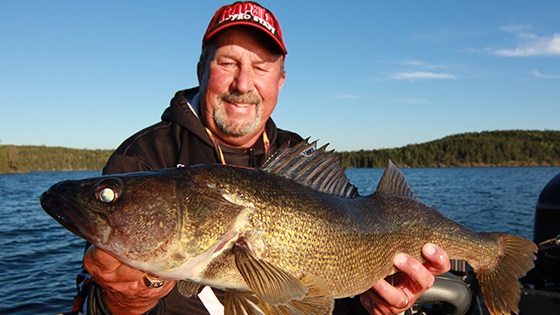 A new bait and some old standbys should produce limits of walleyes this spring, say leading Minnesota guides. When the season opens, Tom Neustrom will be throwing Rapala®’s new Shadow Rap® and VMC® Moon Eye Jigs dressed with minnows, and Tony Roach will be tossing Rapala Rippin’ Rap®s.
A new bait and some old standbys should produce limits of walleyes this spring, say leading Minnesota guides. When the season opens, Tom Neustrom will be throwing Rapala®’s new Shadow Rap® and VMC® Moon Eye Jigs dressed with minnows, and Tony Roach will be tossing Rapala Rippin’ Rap®s.
“Especially on lakes that contain shiners and dwarf ciscoes, that new Shadow Rap should be an awesome bait,” says Neustrom, a Freshwater Fishing Hall of Fame Legendary Guide. “Because it looks exactly like a spottail shiner or a dwarf cisco.”
Featuring a flat sided metallic body finish with textured scales, the Shadow Rap is designed to target fish in two to four feet of water. And although it was unveiled this February at the Bassmaster Classic, it’s not just a bass bait, Neustrom says. Walleyes will crush ‘em too — especially in the spring.
“You don’t necessarily have to twitch ‘em, like you would for a bass, or jerk them,” he says. “Just change your speed and cadence on the retrieve.

Neustrom will tie on a Shadow Rap to target big, post-spawn female walleyes around dark-colored shallow gravel and scattered rock. “They’re up there looking for bait,” he explains. “If you get some sun during the day, that dark rock will warm up and attract baitfish and young-of-the-year fish and the walleyes will be in there looking.”
He’ll target these spots in the evening, rather than in the morning or at midday.
“During the day, they’ll drop down to the first break, because they were up spawning in the evening,” Neustrom explains. “And then they’ll come back up in the low-light period into the shallow water.”
After making a long cast to a prime-looking spot, Neustrom will quickly crank a Shadow Rap down to its maximum running depth and then slow his retrieve. “In the first five cranks, I’ll crank ‘em pretty quick, then all of a sudden, I’ll switch to a really slow retrieve,” he instructs. Before the bait gets back to the boat, he’ll stop and start his retrieve several times.
“Be precise with where you’re throwing and fish it very methodically,” Neustrom says. “Right after ice out, when the water is still pretty cold, they’re not going to be chasing a lot.”
Combining a horizontal struggle with a vertical fade, the Shadow Rap perfectly mimics a wounded minnow’s last moments before it dies. When you pause it on slack line, it shimmies from side to side as it’s suspending there. So even when it’s sitting still, it looks just barely alive.
Neustrom will throw Shadow Raps this spring on 10-pound-test Sufix® 832 Advanced Superline® with a four to five-foot leader of 10-pound-test Sufix Castable Invisiline 100% Fluorocarbon.
Roach’s Rippin’ Rap Regime
Pitching and ripping Rapala Rippin’ Raps around shallow rock piles helps Roach and his clients catch limits of early-season walleyes. The pattern is “ideal” when water temps are within 50 to 55 degrees. The keys are letting the bait fall on a slack line and covering a lot of water.
“The quicker you can get to those fish by power fishing, the better off you’re going to be,” says Roach, an in-demand guide in around Mille Lacs Lake, a famed walleye fishery.
While covering water, Roach pitches a Rippin’ Rap to shallow rock piles, sand flats and break lines, working it back to the boat while repeatedly ripping it up off the bottom and then quickly dropping his rod tip to allow the bait to free fall on a slack line.
“Watch your line, because most of the time, those fish are going to hit it on the fall,” Roach instructs. “That pause is their signal to hit it, 9 times out of 10 times.”
Because early-season walleyes are usually found pretty shallow, pitching to them — rather than trolling for them — prevents spooking them with the boat. “They’re up shallow feeding, looking for bait,” he explains. Later in the spring, when walleyes move out deeper, “where the boat won’t spook the fish,” Roach says, Rippin’ Raps will be productive while trolling or slip-drifting. “Then, it’s more of a vertical jigging technique, but you’re still ripping it up and letting it free fall back to the bottom.” Try that technique in 10 to 14 feet of water on expansive flats.
Because water clarity in the spring is generally pretty clear — especially this year, when there’s been little runoff yet — Roach favors natural colors for early-season walleyes. A lake’s forage will determine which one of the Rippin’ Raps eight available natural-looking color patterns he might start with: Yellow Perch, Pearl Grey Shiner, Olive Green Craw, Helsinki Shad, Gold Chrome, Dark Brown Crawdad, Chrome Blue or Chrome.
“But if I’m not getting bit, will start experimenting with brighter, flashier colors,” Roach says.
Rippin’ Raps are available in four brighter or more exaggerated color patterns: Chartreuse Shad, Chrome Mass Back Shiner, Firetiger and Red Crawdad.
Roach’s go-to sizes are No. 5 and 6, but again, he’ll adjust accordingly based on the size of local forage. He fishes them on 8- to 10-pound braided line with a one-foot to two-foot leader of 10- to 12-pound-test fluorocarbon. If you’re low on either braid or fluoro, you can order Sufix 832 Advanced Superline here and Sufix Castable Invisiline 100% Fluorocarbon here.
Neustrom’s Jig-and-Minnow Technique
A VMC Moon Eye Jig dressed with a minnow “is really tough to beat,” early in the season, says Neustrom, who guides in the Grand Rapids, MN, area. “If the water’s warmer, you can fish slip bobbers and leeches, but I think jig-and-minnow is probably your best alternative early in the season,” he says.
Neustrom usually starts with a 1/4 oz. jig, quickly targeting active fish. “I’m looking for a couple biters,” he explains. “And then I’ll drop down to an 1/8th and work them a little slower; work them a little bit more methodically.”
Also ideal for rigging with soft plastics, this jig features an aspirin shaped head that provides added control and an illusion of a wider profile.
“Because of its pill shape, it drops quicker,” Neustrom explains. “If you’re using a regular ball jig, it has a little bit more resistance. So in a lot of situations where I’d use a 1/4 oz. jig, I can use a 1/8th oz. Moon Eye.”
Moon Eye Jigs are available in a wide range of color patterns, including four UV Bright patterns: Blue Fire UV, Green Fire UV, Orange Fire UV and Pink Fire UV. They come armed with premium VMC high-carbon steel hooks with a top-of-the-line black-nickel finish.
Neustrom fishes Moon Eye Jigs on clear, 6- to 8-pound-test Sufix Elite monofilament line.
